Some weeks ago, Bob Whitaker asked me to do a Mad in America Continuing Education Webinar on the problems stopping Antidepressants. The talk with discussion is here Stopping Antidepressants and responses to points raised will be followed up in forthcoming posts.
I prerecorded the talk in case of disaster as Tapering Antidepressants which is in this link.
The two versions are slightly different – too much to squeeze in. The text below contains even more points some of which got left out of the talk because of time limits.

Slide 1: Way back I sidestepped a medical job to spend time in a research lab. Probably because reading too much Freud left me confused about What it meant to be Mad or Normal. See Swans, Psychopharmacology and Religion.
The SSRIs gave me great answers. When I say SSRIs – I mean your reports of what SSRIs do. This talk is based entirely on what I have heard from you and reports to RxISK.org. You are the experts on being normal and the increasingly crazy world we are in. My job here has been to add the cartoons and a bad joke or two.
Slide 2: As fortune had it, I ended up working on serotonin reuptake 2 years before, Zelmid, the first SSRI, launched in Europe. Prozac was fifth. See Let Them Eat Prozac or Children of the Cure for more on this. This background meant pharma companies thought I was a good person to educate doctors about the SSRIs when they came onstream. This educated me about how companies figure doctors don’t have a thought in their head not put there by them or their competitors.
Slide 3: It also opened a door to interviewing the major psychopharmacology players. How did things look back then? How did the discoveries happen? The interviewees included Arvid Carlsson who created the SSRI idea and Zelmid.
Carlsson made it clear that new gadgets played a bigger role than the brilliance of great men. Get a new gadget that shows where drugs Go – not Do – and see things no-one has seen before and people think you are brilliant. But he also realized that You are the most important gadget – your reports show what drugs do. The SSRIs came from listening to You saying some of older drugs had a serenic effect that others didn’t have and he realized this was likely linked to an action on normal serotonin systems.
Slide 4: As this 1991 article on The Marketing of 5HT says, the SSRIs were anxiolytic rather than antidepressant. But a benzodiazepine crisis meant doctors would not believe there could be an anxiolytic that did not cause dependence whereas no one then thought antidepressants caused dependence. Cases of Valium needed to become cases of Prozac.
Slide 5: My message at Pfizer’s 1992 UK Zoloft launch, which I chaired, is in this article 5HT and Physical Illness. Serotonin is more primitive than Estrogen or Testosterone. Drugs acting on it will show us things we have never seen before. We need to keep our eyes open.
This was a talk given to a company who had abandoned a clinical trial on another drug but found the patients didn’t want to give the medicine back – it was Viagra. Listening to you up till about 1990 had been the way to discover new drugs.
No longer. Pfizer’s message was we know all about Zoloft. Doctors just need to prescribe it and get us to swallow it.
Slide 6: As this cartoon by the great Michael Leunig shows Marketing saw to it that cases of Valium became cases of Prozac and Zoloft and turned SSRIs into Vitamin Serotonin, which corrected a brain abnormality. No hint here of a serenic effect that might be helpful if we knew how to use it or of hazards we should keep an eye out for.
Slide 7: Twenty years beforehand when Carlsson began working on SSRIs neither he nor anyone else thought there was anything wrong with the serotonin system in people who were depressed. He wasn’t trying to fix it – he wanted to act on it. Like LSD, SSRIs act on intact serotonin systems and can produce a range of effects – good and bad. Carlsson was prepared to believe people who told your SSRIs can cause people to become suicidal.
Slide 8: Companies knew SSRIs had hazards from healthy volunteer trials done before marketing, where young people became dizzy, anxious, depressive, suicidal, aggressive, had serious sexual problems and dependence. Traci Johnson aged 19 committed suicide . These studies gave companies a decade head start in preparing their defenses for what they knew would come.
Slide 9: We have a serious brain problem but not the one you think. This famous image illustrates when it started. 400 years ago Rene Descartes, said the true I is a ghost in a machine that is my body, which I will leave behind when I die and go to Heaven or Hell. His proof? Well if our foot strays too near a flame, a flame image runs up nerve fibres to the pineal gland where our soul looking at it decides to move our foot. For Descartes this wise decision demonstrated reflection. The word reflex originally meant we had reflected.
This is where Descartes’ famous Cogito ergo Sum – I Think therefore I am – comes from. Our Bodies are essentially nothing. For more on this see Ghost, Cyborg or Mystery.
Slide 10: It took us 200 years to recognize that there is no reflection in reflexes. The wisdom of the body takes care of things. This opened the door to Sentio ergo Sum – I Feel therefore I am. My body is who I am – a new Mysterious Me?
Slide 11: Soon after, William James and Carl Lange said our Emotions aren’t in our Minds. They result from our brains attempting to work out what our Body is Sensing – what our body is trying to tell us is going on in our inner and outer worlds – and our brains often get things wrong.
Slide 12: A decade later Freud figured he could interpret the automatic and unconscious things going on in our bodies. Rather than listening to and learning from you or me, Freud created a Cogito Ergo Tu Es – What I Think is What You Are. What the Expert thinks is what You who couldn’t possibly Understand Your Body Are. See Images of Trauma.
Freud is Dead but Lives today in Psychopharmacology. Freud based everything on Libido – a word you recognize – but in his hands it was an unreal force, psychobabble, that could mean anything he wanted it to mean. It couldn’t be measured. It let him claim he knew what was going on in you better than you did.
Today Freud’s psychobabble has been replaced by a biobabble. The Serotonin of Psychiatry is as unreal as the Tooth Fairy. It can’t be measured.
But it can be used by The Experts to claim they know better than you what is going on in You and it underpins their scornful laughs when you raise things that contradict their theories. This not Science – like psychoanalysis it has become a Religion..
Slide 13: Seventy years ago Psychopharmacology made more sense than it does now. It followed James-Lange ideas. Tranquilizers like Milltown and later Valium were the best-selling drugs in the world. Older treatments for nerves sedated – they knocked the brain out. Benzos didn’t. They relaxed muscular tension, which fooled brains into thinking we are not anxious.
We now think these drugs act on our brains. When we stop them and get anxious, we blame the person’s brain illness – we don’t say check their muscles out.
Slide 14: Using beta-blockers for anxiety also aimed at fooling brains by blocking rapid heart rates, sweating, or shakes. They are also used to treat cardiac and blood pressure problems and the physicians using them for this, who know nothing about mental health, warn people stopping them not to think that their increased heart rates and shake mean they are anxious.
Beta blockers taught me a key lesson. In a pharmacology practical, I had to give one to a colleague and monitor her pulse which should have slowed down. She became anxious and her pulse rate had gone up. According to the books, this was impossible.
I’m Irish and the short code for Ireland is IRL – also code for In Real Life. This taught me that what is happening in the real world is what is happening in front of you. What is in books is not really real – it can have a big impact on our reality and even be helpful but is not real. .
[Being hypothyroid causes weight gain and thyroid hormone, T4, reverses this. It is used for weight loss in people with no thyroid problems. Endocrinologists just do not believe a woman who is hypothyroid can gain weight on T4 – but they do – Weight Gain on Thyroxine.
There are lots of other examples of people with diabetes or other conditions not behaving the way the books say. Good Care involves engaging with real people not the non-existent averages found in books.]
Slide 15: T Rex here has a reptilian brain. His tiny bird brain was amazingly efficient – no human soul to cause mistakes. There is no cortex. The reptilian brain is really just the upper end of the spinal cord typified by the locus coeruleus – the Blue Dot here and Greenish Dot (which is usually Pink) the Raphe nucleus – which is where the minute amount of serotonin in our brains is .These nuclei monitor our bodies – bladders and bowels more than the environment.
The Cortex you see here is where most of you think our Souls reside. If you let me include this upper bit of the Spinal Cord in our Bodies – then 100% of your serotonin is in your body and none in your brains – none in your soul. If you want to call this Reptilian bit ‘brain’ – then 5% of your serotonin is in your brain.
Slide 16: Do SSRIs, like benzos and beta-blockers, act on the Body and fool the brain?
In 1999, in this Unit in Wales, we randomized healthy medical and nursing staff to either Zoloft or a norepinephrine reuptake inhibitor. Would people spot a serenic effect on Zoloft – the observation that led Arvid Carlsson to create SSRIs? They did – but one in ten also became suicidal.
No patients had any idea the staff were on anything. But within 24-48 hours, patients could tell me – that doctor’s on a drug and could say he’s reacting less – it must be an SSRI. See Experiment at the End of the Millennium.
Staff are supposed to be the trained scientists who based on close observations monitor and adjust treatment, but they don’t notice things like this in patients. Who then are the clinical experts?
Rather than act on muscles or hearts, SSRIs act on sensory systems to reduce our Feelings and Emotions, make us less reactive more serene. Patients, friends and family can see this almost immediately – medical staff can’t.
Slide 17: This should not come as a surprise. This Peanuts cartoon from 30 years ago stems from similar observations. Lucy knows just why Charlie Brown is not reacting the way she’d like. The surprise is that our expert left hands don’t seem to know what our ordinary right hands know.
Slide 18: This Pet Scan from 10 years ago shows what Lucy and patients know. On the Left is a normally lit brain from a group of healthy volunteers. On the Right the same brain after volunteers had one dose of an SSRI. The researchers say Hey look just one dose can turn the brain off.
One dose has not turned this brain off. SSRIs act on sensory systems in our guts, bones, blood, etc to shut them down and the lack of sensory input gives the picture you see here. Our bodies are feeling, less, sensing less, reacting less. If we remove the sensory blockade, what happens?
Slide 19: As you’ve seen with beta-blockers we often get a better sense of what a drug does when we stop it – which is what we are going to do with the SSRIs but first this graph shows you a public health crisis.
Within 3 years of its launch in the UK, British drug regulators had more reports of dependence on paroxetine than they had for the previous 20 years from all benzodiazepines combined. Within a few years of their launch 90% of people on SSRIs were on them chronically as this slide from this Healy Aldred article from 20 years ago shows. .
Before the recent surge in prescribing to kids, we didn’t have more and more people being put on them each year – we had more and more people not able to get off – 15% of most countries now. This public health crisis has been staring us in the face for over 20 years.
GSK’s line at this point was “Sure our trials have shown some mild to moderate withdrawal” – no more on cold turkey than taper. Two escape routes let companies make this claim.
First interpret anxiety and depressive symptoms as an illness relapse rather than withdrawal. Block this escape route and things look very different.
Second people in early company studies were not hooked to SSRIs – had not tried to get off or missed a dose and become suicidal. Many folk in these early short trials could get off. The volunteers for recent Antler and other trials are folk who haven’t had significant difficulties when they miss a dose. Many of these can get off. There is a healthy SSRI taker bias here that can’t be overcome.
It is not possible to run Randomized Controlled Trials for any harms. Like the Peeling Medals at the Paris Olympics, the sheen comes off Gold Standard Medical Research when it comes to harms.
Slide 20: Their healthy volunteer trials gave companies a decade to prepare for this withdrawal crisis. This 1995 campaign by Lilly introduced us to a rebranding. Don’t be silly, this is not dependence or withdrawal – it’s discontinuation. Shrinks were trotted out to say antidepressants are not addictive. Discontinuation syndrome rapidly became a tainted word and in 2003 GSK’s Alastair Benbow casting around for something else came up with the wonderful Symptoms on Stopping – SoS.
Slide 21: The word dependence conjures up a brain problem – as does serotonin the happy chemical. But SSRIs are antihistamines – the drugs you take for itchy skin, allergies, travel sickness, gut problems like ulcers or reflux. Stopping them commonly gives dizziness, nausea, cramps and skin problems, which can be life-threatening but get ignored. See
Side Effexor Withdrawal, and Bladder and Bowel Problems and Serotonin, Intestines and Gravity.
Our skin is continuous with the mucosa lining of our gut. Both are outside us and form the boundary between the world and us. This boundary and not our brains is where the action is. And almost all the serotonin in us lies in the nerve and blood supplies to the gut and skin walls.
As an old joke says, when the surface area of a man’s skin increases slightly, there isn’t enough blood left to get to his brain.
Our hair is part of our skin. When women on antidepressants color their hair – see Hair Zone – things can go dramatically wrong because they are adding dye to the dye already in their hair – antidepressants started life as dyes (See The Antidepressant Era). We don’t figure brains play much part in this dysregulation. And they play no part in any other dysregulations.
Slide 22: Electric head or brain zaps look more like a brain thing. It’s a shocking problem known about for 3 decades. It’s not a brain problem. It’s a scalp muscle, peripheral nerve and eye problem. Moving your eyes quickly can trigger it.
If we were doing science, you’d expect scientists to race in and start researching this new phenomenon. Shockingly they haven’t. Many websites tell us up front no one wants to talk about Electric Head for fear of alarming patients about dependence. Not warning you is important. It’s not OK.
Slide 23: 150 years ago, 3 different German doctors had 3 patients who developed severe anxiety after experiencing an I’m-going-to-die moment in a market-place. One doctor said it’s triggered by a problem processing visual information in crowded places. The others said it’s a neurological problem. The patients all avoided market-places afterwards, giving the new condition its name – agoraphobia. We later learnt blocking avoidance with behaviour therapy could help us manage a way around these problems.
A century later, with his idea of a Panic Attack, Don Klein took us back to the I’m-going-to-die experience and the need to correct this rather than the avoidance behaviour. Klein figured the death experience was caused by a suffocation reflex. It’s not.
Slide 24: The latest version of this, Persistent Postural Perceptual Dizziness PPPD, appeared ten years ago. A woman who was liaising with RxISK for over a decade who had what she and we agreed was Protracted Withdrawal Syndrome, introduced us to PPPD. It’s a better fit she said. See PPPD and Balancing our Bodies.
At the heart of PPPD lies severe dizziness. Even with the word severe, dizziness sounds like a mild problem. Vertigo comes closer to describing the horror. Imagine having Vertigo on a tightrope. This will for sure cause an enduring shock and avoidant behaviors.
Slide 25: Balance takes 2 or more years to master early in life. It has input from the vestibules in our ear, our visual systems and our proprioceptive systems – a set of nerve endings in muscles, bones and joints that tell us where our bodies are. It’s got nothing to do with our cortex or souls.
Serotonin and dopamine are critical for all these sensory receptors and nerves. Mess with them and things fall apart. There are up to a 100 different balance problems we know about – see Ondine’s Curse.
Vestibular Rehabilitation Therapy is an interoceptive behavior therapy. This means it aims at exposing you to the behavior that is causing your problems until you habituate to it. It can definitely help. The problem is waiting lists and in the meantime you are more likely to get trauma therapy or an SSRI.
Balance is a common early side effect of SSRIs. The originators of PPPD do not think starting an SSRI can trigger PPPD although RxISK has several reports of PPPD starting with an SSRI.
Balance problems and vertigo are among the most common and severe problems on stopping SSRIs – even in healthy volunteers after 2 weeks on the drug. They may be linked to Electric Zaps. The PPPD originators agree SSRIs can definitely cause PPPD on stopping. Folk with PPPD however get put on SSRIs, and told they are a Cure, even if their PPPD has come on after stopping an SSRI.
PPPD is a dysregulation of balance systems. It is not linked to the speed of a Taper. It can start on treatment rather than just be linked to stopping.
Recent input from a RxISK reporter based on post-SSRI visual problems led us to ‘Visual Vertigo’ – which echoes what got called agoraphobia in 1870. Visual vertigo can respond to Acetazolamide.
There is a linked post to this section – Interoception or Neuroplasticity.
Slide 26: Look at the Eyeball in Niki McQueen’s extraordinary Juggling Act, which brings balance and visual systems into the picture. Visual Snow Syndrome was outlined a decade ago and features visual snow, palinopsia, nyctalopia, floaters and dizziness.
RxISK carried a report of VSS – Keeping an Eye on the Ball – before VSS was described. These problems have been happening since the 1960s but then were blamed on the anticholinergic rather than the serotoninergic actions of tricyclic antidepressants – Visual Snow Epidemic.
Slide 27: Here is how VS is normally represented. The problem can start on treatment or on stopping and can persist for decades afterwards. It has nothing to do with tapering. It is eye based not brain based – although ophthalmologists would like to palm it off as someone else’s problem.
These top two slides feature palinopsia and nyctalopia.
Slide 28: The one below them shows floaters. We all have occasional floaters, which our ophthalmologists can see. VSS can cause multiple floaters, which ophthalmologists cannot see.
Ditto with the little wisps of white against the blue background- you’ll have to increase the size of this image to see them. These wisps are not out there in the sky, they are in your eye – entoptic – but ophthalmologists can’t see them.
People with VSS think they are going mad anyway without ophthalmologists telling them there is nothing wrong with their eyes. Doctors cannot understand why people with VSS end up unable to work, unable to drive a car at night, or socialize, and threatening suicide.
Slide 29: Ophthalmologists like the idea that VSS is a Functional Neurological disorder. FND is the modern equivalent of hysteria – to be treated with SSRIs or trauma therapy.
As we have become over-specialized, FND is increasingly diagnosed in drug-induced toxicity cases by specialists from urologists to ophthalmologists. Drug toxicity faces specialists with features outside their specialist area. Scared to blame the drug, the path of least resistance is to blame the patient. An FND diagnosis is a kiss of death for anyone who wants to be taken seriously.
If Vertigo and Visual Snow can trigger an anxiety or FND diagnosis, Anxiety or Depression certainly will. In addition to Vertigo, after exposure to an SSRI for two weeks, healthy volunteers complained of Anxiety and Depression. Almost no-one can see drug toxicity or withdrawal when someone says they are anxious. We can’t see our brains being fooled or company brains fooling us.
PPPD and VSS are just two of the many dysregulations SSRIs can cause. They are not linked to the speed of a taper or avoided by slow tapering and can persist for decades.
A reporter to RxISK recently opened our eyes to the possibility that Acetazolamide might help part of his VSS syndrome.
Slide 30: One of these two is or perhaps years ago was on an antidepressant and now has PSSD – Post-SSRI Sexual Dysfunction. Their genitals are numb, orgasms and libido non-existent. they aren’t warned about this because we don’t want to deter people from getting treatment. Their partner, who is also affected, isn’t informed about this either. Both of you are gaslighted. .
How many people are affected – Roughly 10% of every Western country.
The entire country is also affected if his sperm counts vanish as they do on SSRIs. Or she has failed implantations, fetal deaths in utero and birth defects in her children. Where is the national conversation about this?
No one is told fertility rates have fallen way below reproductive replacement rates and Western societies need immigration or our social structures will collapse. We need immigrants who rely on their communities for support rather than take psychotropic drugs. We have to stop telling trainee doctors from immigrant communities that their job is to overcome the medieval stigma against pills that older members of their tribe have.
Slide 31: We’ve known since the 1960s that within 30 minutes of a first SRI in one tenth of an antidepressant dose, people get genitally numb. We’ve been using this to treat premature ejaculation but you aren’t told. See Serotonin, Fertility and France for a sex and serotonin timeline.
In the mid-1980s over half of healthy volunteers had serious sexual problems on SSRIs. Investigators like me were told about this but were told not to ask about sex in clinical trials – leaving companies able to claim less than 5% of people had sexual issues and hint any problem would clear on stopping treatment. By then it was known that problems could endure for ever after stopping treatment.
A quarter of a century ago, a woman confronted me with PSSD – telling me she had been off treatment for more than 3 months and could take a hard-bristled brush and rub it up and down her genitals and feel nothing. No condition in medicine can cause numbing like this – except a rare genetic defect of PIEZO2 proteins. PIEZO proteins are mechano-sensory receptors – that tell us when tissues from our bowel or bladder to infected skin or genitals are stretched and we need to take the appropriate action.
There is both an erotic touch numbing and normal touch based numbing. One or both of these correlate closely with the emotional numbing people report on these SSRIs. the fact that emotional numbing links to reduced sensory input maps perfectly onto James-Lange ideas. .
PSSD is a withdrawal problem but as with the visual problems, it can start while on treatment – it is not caused by tapering too fast and not solved by restarting.
Slide 32 and 33: In helping tease out who is Mad and who is Normal and what meds really do, this podcast featuring Roy, Bryn and Simon is worth more than the medical literature on these drugs. It echoes what the patients taught me in the Healthy Volunteer trial. I cannot recommend it too highly.
Bryn: Getting PSSD undermines your faith in the medical establishment and the whole system of science as we have it – the fact that none of these professionals understand this condition or know anything about it when we know we have it – it’s not some vague feeling. Losing you libido is equivalent to going blind or deaf, it’s that level of sensory impairment
Roy: The same can be said for losing your emotions – I felt I lost two senses – my sexuality and my emotions
Bryn: If we want to be believed we have to remember just how incredible our story sounds … It’s a hard thing to wrap your head around… My Dad says it’s not possible a drug could cause these effects, it wouldn’t be on the market.
Most people would also not believe that FDA would let a drug on the market that could cause the reproductive replacement rate to fall so low. There really should be a national conversation about the SSRI group of drugs – a good time would be in the forthcoming Harris-Trump debate but that is not likely to happen.
Slide 34: Just as beta blockers can slow or speed up a heart rate, so also SSRIs on starting or stopping can cause Genital Numbing or Genital Akathisia which can lead to Persistent Genital Arousal Disorder (PGAD). We have known about this since the mid-1980s. It comes with ego-alien and repeated orgasms so distressing that women have resorted to clitoridectomies to control it. My PGAD Nightmare.
PGAD is however not the opposite to PGAD. It is most common in peri-menopausal women, may respond to Acetazolamide and points to an interaction between Estrogen and Serotonin.
Slide 35: Bruce Springsteen’s happy place is on a paddleboard. There are Pictures Galore of him on his board – all copyrighted. In Born to Run Bruce describes being out on his board one day when he bursts into tears for no reason. He calls his doctor who suggests restarting a teeny dose of his SSRI and magically the problem clears.
This phenomenon was known about before we got SSRIs. It gets triggered for no apparent reason and responds to very low doses of an SSRI – 1-2 mgs. Current withdrawal wisdom has lots of people reporting something similar – they stop and have strange things happen that clear on reinstituting a fraction of their prior dose. This has nothing to do with tapering fast or slow but it get’s built into the tapering narrative.
Slide 36: Here’s Bruce again with a great description of akathisia – although he does not call it that or even hint its a problem caused by the drugs, perhaps told by his doctor or some President to never blame the drugs for fear of ending up with blood on his hands.:
I was so profoundly uncomfortable in my own skin that I just wanted OUT. It feels dangerous and brings plenty of unwanted thoughts.
I was uncomfortable standing …walking …sitting down… everything brought waves of an agitated anxiety
I’d try to find a position I would feel all right in for a few minutes.. I’d pace the room looking for the twelve square inches of carpet where I might find release…
For the first time, I understood what drives people toward the abyss. The fact that I could feel this left me in a cold fright. There was no life here, just an endless irritating existential angst embedded in my bones. It was demanding answers that I did not have.
Again Bruce calls his doctor. This time the Doc does not suggest a teeny dose of an SSRI. This would be disastrous. Instead he suggests clonazepam which works like magic. This is akathisia – clonazepam does not help depression and a teeny dose of an SSRI risks making akathisia worse with people deteriorating and ending up on ever higher doses. The point is there are dysregulations that can respond to a teeny increase in dose and others that are made worse by exactly the same advice.
Slide 37: Bruce hints these akathisic states might cause suicide. In SSRI clinical trials, the withdrawal from prior psychotropics was the riskiest phase. When companies did this, the suicidal event rate went through the roof. But as people were now on nothing, companies said this is like being on placebo and we can add these events into the placebo group to make our new drugs look good. This quacks like fraud. It breaches FDA regulations but FDA have a public health brief – keep pharmaceutical companies healthy – and they turned a blind eye.
Slide 38: These data are from Study 329 of paroxetine in children. Few people have seen them. They show the highest suicidal event rate was in the Taper phase. So Bruce is right about this.
Slide 39: A decade ago, Anne-Marie made RxISK aware that SSRIs make her and others alcoholic – see SSRIs and Alcohol. Her work is now embodied in Canadian Guidelines for Alcohol Use Disorders, which advise checking recent onset alcohol problems for evidence of an SSRI induced element –
Linked to that there is growing awareness psychotropic drugs may trigger other substance use disorders – as we attempt to treat ourselves. Did my Doctor Make me a Substance Abuser?.
How might alcohol help? Alcohol is a great treatment for akathisia. It acts very like the way Clonazepam acted for Bruce. Are we driving people to drink?
Slide 40: This graph brings out important points. First, 20 mg is beyond the top of Prozac’s dose range. Company data showed 5 mg was just as good but Prozac was such a poor antidepressant Lilly took no chances with the clinical trial dose. Somewhere between 1-5 mg would have been appropriate – instead everyone put on the lowest possible dose has effectively been injured.
Worse again, 20 mg sounded a low dose to most doctors and the dose was pushed up and up to 80 mg.
Second starting with Bob Fiddaman way back and people who set up Paxil Progress and continuing through Adele Framer, Peter Groot, Mark Horowitz, David Taylor, James Moore, Angie Peacock and all of the folk running the PSSD Network and RxISK have been heroic. They persuade me because of what we call their Lived Experience – which are tame words for the capacity to remain so sane and balanced in the midst of terrible difficulties and able to reach out and help others.
This graph is about Hyperbolic Tapering – an idea that has helped persuade many to try stopping their antidepressants. Hyperbolic tapering it suggests now lets us put the science on your side. Getting people to try and stop is a great thing because many can do it.
But while Hyperbolic Tapering is nearly as effective in helping people think about getting off meds, as the Low Serotonin Myth was at getting them on meds – it is also Mythic.
Tapering is not always necessary but is a good idea. Peter Groot’s tapering strips are a practical help to Taper – better than shaving pills, or counting beads.
The trouble with the hyperbolic element is that there are lots of features of the problem that it doesn’t address at all – and it silences the people who have those problems. It also makes it easy for pharma to say – look getting off these meds is easy, just taper and if you can’t do it well that’s a problem in you rather than in our pills.
Slide 41: Why is hyperbolic tapering not right?:
- First there is a mismatch in the X and Y axes here. This is a trick pharma often use to fool folk. Make the X and Y curve equivalent and the curve flattens out
- Second, beta-blockers, anticholinergics and norepinephrine reuptake inhibitors show the same binding curves. Cold turkeying them can cause a problem – that last 48-72 hours, whereas SSRIs take 48-72 weeks or months. Stopping SSRIs is not about events at the reuptake site – it is about dysregulations happening beyond that site.
- Third, we manage opioid and alcohol withdrawal without mentioning binding to opioid or alcohol receptors. Why would SSRIs be different?
- Fourth, lots of folk cold-turkey easily while others can’t stop with tapering over years – See Jon and Justin’s Journeys.
- Fifth, why would tapering help problems that start before stopping – like VSS, PSSD and others.
- Finally what is not mentioned about SSRIs is they are orthosteric rather than allosteric agents. This means they bind too tightly to and damage receptors rather than act more gently on them like anticholinergic drugs for instance.
Having made these points about Hyperbolic Tapering I need to give readers a link to an interview with Mark Horowitz and David Taylor about where this idea came from
Slide 42: Our brains are not the source of our problems stopping SSRIs but they are a source of stopping problems. Pharma programs your brain and your doctors’ brains to get you thinking the way they want you to think. This operation looks painful but many Docs are happy with the result.
Slide 43: The latest program says ‘precision psychiatry’ – I don’t want to focus on the words precision psychiatry or I’ll start laughing and won’t be able to stop – it will be the end of the lecture.
Slide 44: The Pharma program is about Magic Bullets that go to where the problem is and exterminate the enemy. This narrative hands control to pharma – the only role for doctors is to prescribe – and never not prescribe – and for patients to swallow.
Slide 45: Most medicines however embody therapeutic principles – that can be put to good use if we get the right principle for the right person.
Laxatives and constipation come in 4 different kinds. The skill lies in figuring which therapeutic principle suits you. Once a company gets licensed to call their drug a laxative, their interest lies in getting everyone with constipation on it. They don’t care if you are also on the other 3 types. But you should care because this is how we get treatment resistant constipation.
This applies to all meds – antihypertensives, hypoglycemics etc. Antidepressants offer Serenic Serotonergic, norepinephrine vigilance enhancing, sleep and appetite enhancing tonic principles with mirtazapine and a principle to treat melancholia maybe because of the anticholinergic euphoriant principle tricyclics have. The right drug for the right person can help. The wrong one can create treatment resistant depression. If the wrong one is an SSRI for instance, we give people a complex chemical imbalance for which there is no treatment and for which an increasing number of people seek Medical Assistance in Dying.
Slide 46: Anniek Lemmens featured recently in Last Step to Recovery on Mad in America. Her protracted withdrawal probl4ms led to MAiD. She had hearing issues that were almost certainly sensory not brain based but she was told her brain was broken and could not be treated. A different model for what was happening her might have made a difference.
Slide 47: Therapeutic principles take the narrative back from pharma and hand it to us. Some years ago a man with bad OCD came to me. He risked losing his job as his OCD made handling complex wiring systems like this a torture. We tried SSRIs. Manipulated doses, switched drugs. No help.
Weeks later, he was better and confessed to stopping my meds. He had also taken up smoking. He’d researched nicotine and found studies showing it can help OCD. The top paper he handed me had an author I knew – Arvid Carlsson. Listening to patients, Carlsson created SSRIs to embody a therapeutic principle he expected would help some but not all people. In the same way he found nicotine could also be a therapeutic principle for OCD that suited some people better than SSRI.
This hands the narrative back to us. Only my patient, not FDA who claim to license meds on a benefit risk basis, can compare the respective benefits of nicotine and SSRIs for him. He knows what the hazards of taking nicotine every day of his life are. They are almost certainly no worse than the hazards of SSRIs or antipsychotics every day for the rest of a life – See Antidepressants and Premature Death..
Slide 48: Getting you off the pills, we need to recognize that:
- Everyone – Biden, Trump, and the Pope to AMA, APA, FDA, EMA, Royal College of Psychiatrists live in a unreal world of Sacraments Good Drugs than can do no Harm and Bad drugs that can do no Good. They will not let you blaspheme and say the Good Drugs can Harm – when the Good and Bad comes from us not the Drug.
- Partialists – doctors who know more and more about less and less – Dee Mangin’s word for Specialists add to the problem. See Generalists, Partialists and Judas Goats.
- The Lying in the Medical Literature is our of control.
- Antidepressant Dysregulations vary from person to person and drug to drug
- We need a model for the complex chemical imbalance SSRIs create in our bodies. Without a model to guide us confusion sets in.
- We have a Dangerous Brain Bias that Medical Specialization is making worse.
Slide 49: Let’s take Brain Bias first. As with all drug toxicities, Fluoroquinolone Toxicity – Flox-Tox – affects many bodily systems with our brains left trying to interpret what’s going on leaving us struggling with anxiety, depression, confusion and paranoia. Physicians hear this as mental stuff and call a shrink – who will dump SSRIs, mood stabilizers and antipsychotics into the mix and kill the patient. The same happened with Covid and vaccine problems, which SSRIs don’t help. Shrinks know nothing about toxicity.
If it has a Serenic effect, an SSRI might help your OCD or job stress, but using an SSRI to treat any toxic effects, even SSRI toxic effects, risks adding to the toxicity. You don’t want a shrink in a situation like this. You need someone who knows about toxicity perhaps a good generalist.
Slide 50: There is a group of people who have intense adverse physical experiences regularly but who survive better because they expect them and know why they are getting them – these are women getting hot flashes. Having a context can make a big difference. Hence the need for a model.
Slide 51: This image is from a video of a professional women, a leading lawyer perhaps, designed to convey a ‘you wouldn’t contradict me’ message. She is on an SSRI for her menopausal Hot Flashes. In my experience women with absolutely zero nervous problems, women capable of leading the Free World, are among those who have the greatest difficulties stopping an SSRI when put on them for this purpose. There is a link between these two primitive hormones – Estrogen and Serotonin.
Slide 52. Twenty years ago, SSRI companies created PMDD and claimed their drugs helped. Prozac was rebranded as Sarafem for PMDD. The Irritability element of this advert hints at akathisia. While some numbing might help in some cases, trial data for SSRIs, in fact, show dramatically increased risks of aggression on SSRI compared to placebo.
I am showing you this because again we have an Estrogen Serotonin link but also there is a treatment that seems to help PMDD especially when SSRIs don’t help, Acetazolamide, a treatment that helps visual vertigo and visual snow also and may help PGAD which also hints at akathisia and shows an interaction between SSRIs and Estrogen.
Slide 53: This leads me to suggest recasting SSRI SoS as more like the menopause than opioid addiction. SSRIs cause drug dysregulation syndromes. You can download all these slides from RxISK. In particular look at this one. Almost all the Menopause SoS map onto Seropause SoS – electric zaps, dizziness, brain fog, paresthesia etc.
This slide asks why does the menopause have so many symptoms? Because Estrogen affects almost every bodily tissue. Well Serotonin is more primitive than Estrogen and affects every bodily tissue also.
In terms of stopping serotonergic meds a menopause dysregulation model suggests:
- Some folk may sail through without problems whereas others can have a debilitating experience.
- The likelihood of what kind of sero/menopause you have is shaped by your genes.
- It can last for years
- The dysregulations can differ from person to person.
- Few people would dare say they know better what’s going on than the woman managing what is happening her.

Slide 54: Brain Fog features as a symptom that leaves many thinking their brain is broken. Just the opposite. When automatic unconscious functions like playing a piano, your golf swing or Gymnastic routines aren’t working right, or you can’t depend on bladders or bowels, thinking doesn’t help. Thinking is effortful. It messes things up even more and makes us more aware of our failures. The answer is brute repetition so that what was once unconscious becomes unconscious again.
Slide 55: This brings me back to Juggling. We spend years juggling our bodies to the point where we can do some miraculous things. Two year olds bop when music is put on, no one teaches them to do this. We can build more complex dancing or acting on this – but without it, there would be no ballet or theater.
Significant withdrawal problems on psychotropic drugs need a lot of brute rebalancing of complex bodily functions. Routine activity that creates predictable signals is important for things like sleep. It will be like starting over again.
Slide 56: Helping you may involve Messing with your Mind:
- Recognizing a return of feelings – it can take years for the full color to return to life – The Color of Life..
- A change in personality – this is the theme of a webinar here in 4 weeks time – The Story of SSRI Stories.
- Interoceptive Therapies – for PPPD and perhaps other elements – see above.
- The role of Cancer and Infections; We’ve known for two centuries mental illnesses and cancers can clear up with infections. Likely something to do with immunity. But the same effects are probably even more likely to make things worse and a therapist should never pretend to know what is going on when things change for the better or the worse.
- Don’t Gaslight. No therapist has a clue what is going on here and should not pretend they do. Resist the temptation to undertake trauma therapy unless you have the guts to stand with your patient in front their prescriber.
Slide 57: We can poison you. The options include
- Nicotine and Alcohol – cherish the moment a doctor advises thinking about nicotine or alcohol. Nicotine not because it is good for withdrawal but lots of people on SSRIs are stuck on drugs that never worked for them in the first place and replacing these with something that does work might be no harm..
- Oxybutynin, Cyclizine and Benztropine – after nicotine and alcohol anticholinergic drugs are the most vilified in all of medicine but in fact are the only ones that stimulate regrowth of the nerve fibres that Antidepressants damage most.
- DMSO and P-5-P – See P-5-P and DMSO.
- Lithium – See Lithium and Vision.
- Diphenhydramine, Dosulepin and Nortriptyline – See Antidepressant Withdrawal.
- Acetazolamide is good for Visual Vertigo, PMDD and menstrual migraine, Visual Snow. possibly PGAD and other forms of akathisia. It is also good for altitude sickness and SSRIs don’t work at altitude.. It is a treatment for glaucoma which SSRIs can induce by increasing fluid production in the eye. SSRIs are carbonic anhydrase activators. Acetazolamide is a Carbonic Anhydrase Inhibitor, which is how it helps for altitude sickness and can be used as an anticonvulsant.
Slide 58: When it comes to reducing medication burdens and getting off potentially explosive medicines like SSRIs, You who are on the meds are key to the Science. Anyone else wanting to take part in this scientific experiment can only do so by working with someone in whom an experiment is taking place and accepting that everyone will be different.
Science is a matter of observations and observed differences between us confirm rather than refute the claim that this is science. Science aims at individuality whether it be genes, stars or people.
Doctors or therapists who try to get you to believe what they believe in – the Bible, Koran, DSM, Guidelines – are practicing Religion not Science
Slide 59: The RxISK marketing department have knocked up a Science Manifesto. The opening conversation between doctor and patient looks like this.
Slide 60: In nine cases out for ten for which these drugs are first started, as she says, she will likely be fine in a few weeks without meds. He will secretly be pleased, His life will be much more fun if he has 100 free research assistants, like her, than if he has 100 heart-sink patients who don’t respond as the guidelines say they should. This is what Normal should look like. You do all the research and I get to have my name on a paper.
Slide 61: Here is what Madness looks like. I’ve been telling US medics for 20 years if the pills work wonderfully well and are free of problems – they are out of business. They are now rapidly being replaced by cheaper prescribers – nurses, physician associates. It’s too late for our Doc. He’s toast. But that won’t save you or me
Slide 62: This is not necessarily good news for you. Like a tidal wave replacements, nurse prescribers, pharmacists and others are rushing in to replace doctors and they will be even more completely programmed to get us to conform. How can You – can We – stand our ground?
New gadgets showed Arvid Carlsson where drugs go. Go not do. For Carlsson, you were the ultimate instrument in which the experiment took place. His breakthroughs came from listening to You. You have contributed to Nobel Prize winning research.
Around 1968, Carlsson began working on SSRIs. His work should have demolished the Ghost in the Machine and the Freudian Experts who claim to know more about you than you know yourself. We now have gazillions more of them than ever before and its growing the whole time – Shrinks, Psychologists, Coaches, Counsellors, Therapists etc.
Instead, just as he began to make the first SSRI, the Revolutions of 1968 swept across Europe. The Democratic Party National Congress was in Chicago that year and it was a Warzone. There were revolutions from Paris to Prague and Tokyo – see Creation of Psychopharmacology and Burn Baby Burn.
The Revolutionaries – people like Bob and me and you – were worried that if we lost the Ghost in Our Machines we would lose our Individual Souls – we would be dehumanized – and Carlsson’s work did threaten that.. .
Our Brains, where the ghost was, however, are the means through which Social Pressures operating through Churches, States, Companies and weirdly Biological Psychiatry, are brought to bear on us – these social pressures aim at getting us to Conform – they do not want us to be individual.
Our Bodies, Our Mysterious Me, are the source of our individuality. Saying something like this would have got me accused of biological reductionism in 1968. Our Bodies are more Mysterious than anyone thought in 1968. We are each a Mysterious Me that is part of a Mysterious US. Science does aim at pinning down individual genes but just as galaxies are more than their individual stars, we are more than our genes.
This Us is key to Science. The Science of Us needs the differences between Us. I don’t mean different points of view, I mean different experiences. It’s in listening to each others bodily differences and coming to a consensus about what we hear, see and smell that we will find out Who We Are.
We face a growing craziness in the world today, more clearly on show with SSRIs than almost anything else. In the midst of all this, you are on or have been on these drugs are shedding more light on things we need answers for than almost anyone else. You need to, we need to, insist on your Truth. Good people will stick with you. Proper Science enriches all of us in the sense of enables to better understand ourselves and help each other.
If what’s going on primarily leads to Companies, Professions or States getting wealthy – then it ain’t Science. It ain’t serving Us. It’s a Body Grab.
This talk has celebrated your input to drawing a line between Sanity and Insanity. There are other darker things you have also reported linked to these drugs. You are better placed than Popes, Chief Rabbis, Ayatollahs or Presidents to tell us about these things We to hear about.
This further installment on things we would not know about without your input will be the subject of the conversation in 4 weeks time – I hope you will be able to join Us.

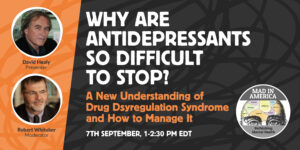


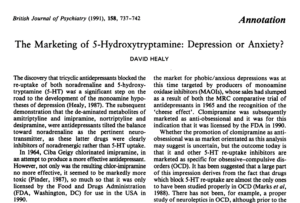
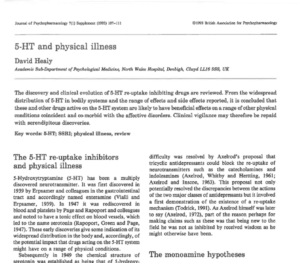
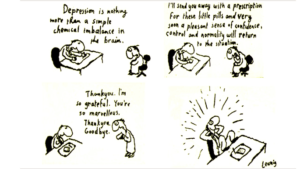



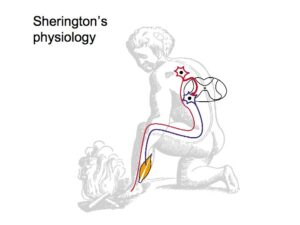

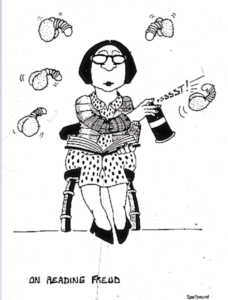

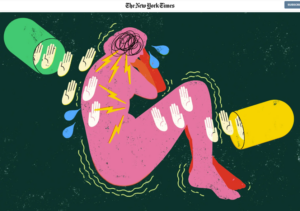
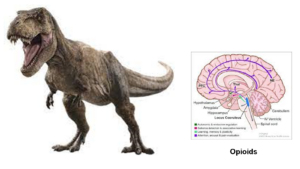

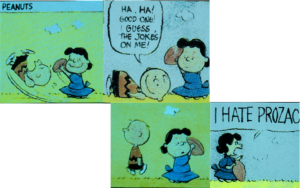
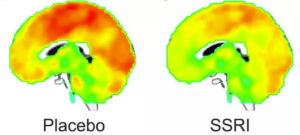
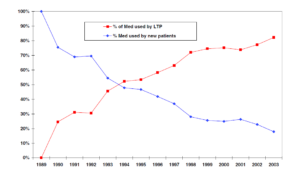
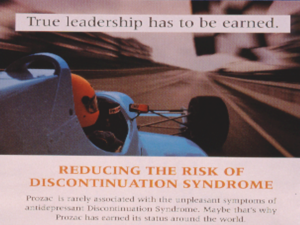

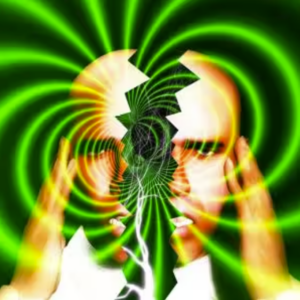


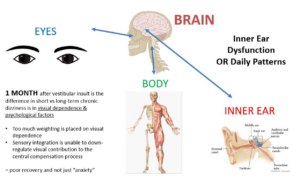
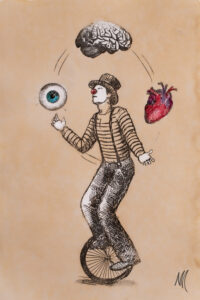





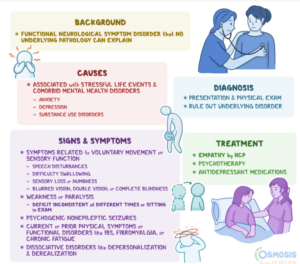

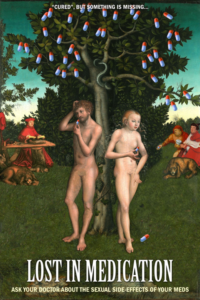
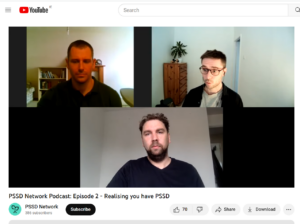



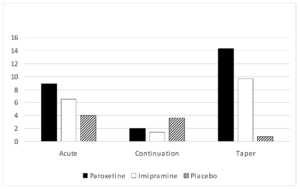
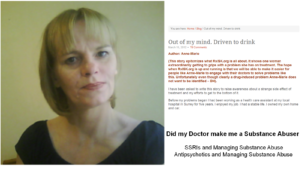

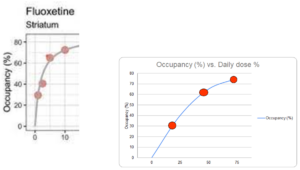
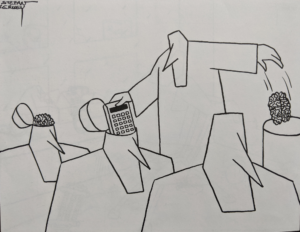
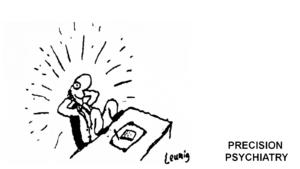
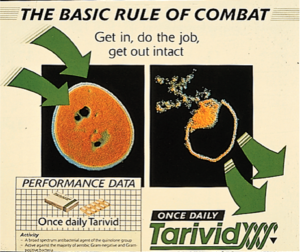

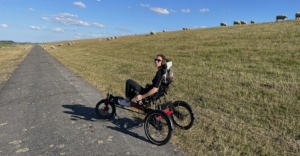

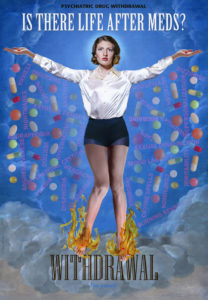
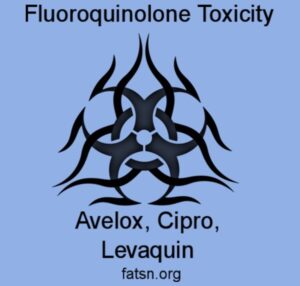



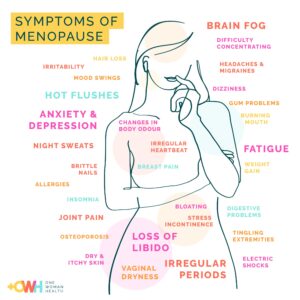
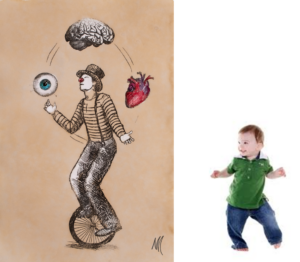

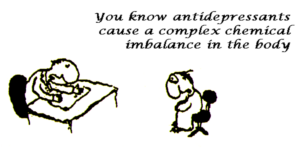
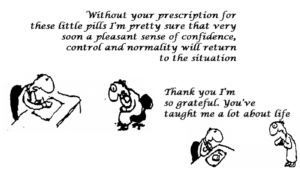
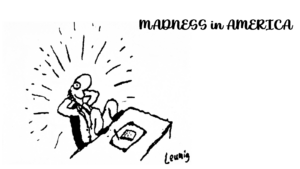

Patrick D Hahn says
Antidepressants are addictive according to the dictionary definition of the word, and there is no other definition. There is no diagnostic category called “addiction” in the DSM.
For our health services industry to argue from authority that antidepressants are not addictive when that word is not in their professional lexicon is the height of mendacity.
It’s amazing how many even the Critical psychiatry movement have drunk the Kool-Aid on this one. One prominent patient advocate became very angry at me for insisting AD’s are addictive. I suggest she is looking for justice in the wrong place.
Dr. David Healy says
Patrick
You are right in the sense companies set out to create or exploit confusion. But in the larger frame of things, it gets more difficult to decide on the best way forward.
Thirty years ago, common sense views on the word addition would have entirely supported calling antidepressants addictive but even this was a mixed picture. Norepinephrine reuptake inhibitors and other ‘antidepressants’ have some rebound symptoms – like beta blockers or anticholinergic drugs so but we don’t call them addictive. These drugs unlike the SSRS (and many antipsychotics) simply cannot be stopped.
While the SSRIs can disinhibit and do a lot of weird things, the problems with them also do not involve a feel-good factor as with opioids, alcohol or stimulants or what get’s called cravings – leading to people being unable to resist returning to them after stopping.
The companies I think have won with the game with the ‘consumers’ of these drugs – doctors that is – who now pretty universally agree SSRIs are not addictive.
Another problem for us is if we claim they are addictive, the common sense position then for people addicted to them is to ask for the protocols to get me off them – like there are for opioids or alcohol.
This is why I think we need a different model and different set of words. We wouldn’t say women going through the menopause are or were addicted to Estrogen. Dysregulated by having it removed yes but addicted no – even though you could spin words to say they crave certain things back but I don’t know that taking HRT is the same thing. I may be wrong but something like serotonergic dysregulation comes closer to the lived experience of people – something that is quite different to what happens to us with most other drugs.
Let’s hope we can get a conversation going and that it will lead to something useful. The problem then will be that ‘we’ don’t have the distribution channel that Pharma has
David
Peter C. Groot says
Physical depence to me seems a proper way to describe the problem patients have to deal with, with no need to getting involved in heated and often rather useless – because they do not really help people – discussions about addictive or not addictive
Dr. David Healy says
Peter
Unfortunately in English and American the word dependence screams addiction. Doctors as the consumers of company products – by putting them in your mouth – mostly accept the drugs neither cause addiction not dependence – they see the too going hand in hand.
David
JB says
Physical dependance is a better word for it. But psychiatry brings it as physical dependance is ok all to avoid the ‘addiction’ label.
But physical dependance is 10 times worse compared to addiction since when stopping a drug while you’re physically dependant on it your nervous system will get a hit and crashes.
Same in my case, severe disabled after stopping an SSRI where i was ‘physically dependant’ on after only 5 months. 4 years later i’m still living a tortured housebound life in hell.
If i could redo my life i would rather be ‘addicted’ to a street drug than be ‘physically dependant’ on these satanic SSRI’s.
addiction is problematic, but can be overcome
physical dependance is pure torturous life ruining hell.
Dr. David Healy says
Peter Groot helped put the idea of dysregulation rather than dependence on the map. Dependence locates the problem in you. Dysregulation suggests your doctor has caused you a problem. Calling it Iatrogenic Dysregulation makes the point even more clearly. But Greek words like Iatrogenic do not work for people
The other problem with physical dependence is people get referred to substance misuse services and lumped in with opioid and other users who have entirely different needs.
The system needs to realize it has caused the problem and it should feel a moral onus to put things right
D
tim says
Agree with DH here.
Absolutely essential that those who have caused grievous prescription drug harm are identified by the terminology used to define the injuries and suffering.
Iatrogenic Dysregulation works well for those familiar with the iatrogenic terminology. Not always a well recognised concept however.
I have searched for possible alternative – difficult.
Would ‘MED’ be useable? ‘Medically Engendered Dysregulation’.
Lays blame/fault/failure with those responsible?
‘Physiological Dependence’ not only fails to identify the real cause of multiple pathology, the term implies weakness, failure and/or guilt – even ‘Misuse” on behalf of a patient who trusted the prescriber and followed their advice.
It seems almost impossible to seek compensation for injuries caused by psychotropic drug toxicity, and psychiatry that would likely be heavily compensated in any other area of medical practice.
With so many lives lost, or reduced to existence with medically engendered dysregulation disability, the failure to compensate the innocent injured is unacceptable
Dr Pedro says
It’s most important to get an acronym for this condition that catches on especially if you have complicated technical words like Serotonergic And Dysregulation. SAD (Seasonal Affective Disorder) has already been taken, has become well known and this has entered the lexicon.
So, as important as the name is the acronym. Serotonergic Dysregulation Syndrome SDS might catch on but whatever it is it must be used as often as we can
NC says
I’ve been trying to suggest serotonin reuptake inhibitor induced neurological dysfunction (SIND) as it’s analogous to the term BIND already in use for benzodiazepines. I’m not sure how you would pronounce it though – “sinned” or “signed”?
There’s currently a movement of some in the PSSD community to try to change PSSD to post-SSRI syndrome (PSS) because they feel that “post-SSRI sexual dysfunction” doesn’t capture the scope/severity of what they have. I get where they’re coming from but there are many people who only have sexual symptoms, and then there are people who have only non-sexual symptoms like emotional/cognitive dysfunction or other sensory/autonomic issues so it doesn’t make sense to me to say all of these people have the same post-SSRI “syndrome” since syndrome implies a group of symptoms that consistently co-occurs. But it would be accurate to say they all have SRI-induced neurological dysfunction (or dysregulation).
Dr. David Healy says
NC
I think this is a fabulous contribution. Especially if we leave out the D – The N can stand for neurological dysfunction/dysregulation. So SIN and we are all SINners – asking what did we or our parents do in a past life to deserve this punishment.
People with PSSD unquestionably have a lot of other things wrong with them -but they have a distinctive problem also – just as people with Visual Snow have – who may also have lots of other serotonin related things wrong with them. We are going to make more progress if we work what has gone specifically wrong in genital numbing or visual snow that if we ask to get everything solved all in one go.
But above all we need people to keep asking questions and not splitting into camps. Akathisia is a terrible problem and lots of people who have lost family and friends to it figure they can solve it and they set up their own organizations rather than co-operate. We need to avoid doing this
David
Harriet Vogt says
Here’s another one for the conceptual pot…
DINDs – Drug induced neurological disorders – is a recognised term it seems amongst neurophysiologists (at least):
‘Drug-induced neurological disorders (DINDs) are important because early
recognition and drug withdrawal can prevent irreversible damage. This review
deals specifically with the recognised neurological complications of prescription-only, single-agent therapy, either at recommended doses or in excess (including overdose and abuse of pre-scription drugs), and summarises the more important DINDs.’
https://www.researchgate.net/publication/6339422_Drug-induced_disorders_of_the_nervous_system
This is an old paper – but a goodie.
More important – the author, Mark Baker, is still at Newcastle and sounds like he may have some very relevant expertise:
Mark Baker is Honorary Professor of Experimental Neurology at Newcastle University and a Consultant in Clinical Neurophysiology at Newcastle upon Tyne Hospitals NHS Foundation Trust, based at the Royal Victoria Infirmary. His areas of expertise are SENSORIMOTOR SYSTEMS NEUROSCIENCE and experimental neurology
https://www.ncl.ac.uk/medical-sciences/people/profile/markbaker.html
Maybe worth you making contact, David?
annie says
The closest lifeline?
Adverse Drug Effects, Withdrawal, Side effects, Discontinuation Symptoms, Symptoms on Stopping, *Serotonergic Dysregulation Syndrome*
Slide 20:
‘Backed into a corner by Panorama’s Shelley Jofre in 2003, GSK’s Alastair Benbow was faced with an accusation that GSK’s Paxil – Seroxat was addictive. No it’s not he said. He had a snag though, he couldn’t use the words withdrawal or dependence, as to most people these sound like addiction words. Around 1995, the SSRI companies spent millions trying to rewrite the English language getting doctors to stop using “withdrawal” and to start using “discontinuation” instead.
But soon after discontinuation was coined, Lilly launched an attack on GSK, saying Paxil-Seroxat was bad for discontinuation problems. Discontinuation began to develop its own unsavory odor. So for a few reasons Alastair couldn’t used discontinuation. Whether it was a flash of inspiration or blind panic, he reached for the closest lifeline – people can have Symptoms on Stopping, he said’
*Withdrawal*
https://www.rcpsych.ac.uk/mental-health/treatments-and-wellbeing/stopping-antidepressants
*Side effects*
https://www.nhs.uk/mental-health/talking-therapies-medicine-treatments/medicines-and-psychiatry/ssri-antidepressants/overview/
‘It’s thought that SSRIs work by increasing serotonin levels in the brain.’
*Withdrawal symptoms* and *Side effects*
https://www.nhs.uk/mental-health/talking-therapies-medicine-treatments/medicines-and-psychiatry/antidepressants/overview/
‘It’s thought they work by increasing levels of chemicals in the brain called neurotransmitters.’
– SSRIs – Selective serotonin reuptake inhibitors
– Antidepressants
Seems there is way to go with dismantling ‘language’ …
annie says
Primal Fear – In Real Life…
‘ It’s a Body Grab’.
I would also add to the ‘mind and brain’ grab –
I listened to the Webinar yesterday, I have read the new post.
I have looked at the links.
David explains succinctly what is going on:
One dose has not turned this brain off. SSRIs act on sensory systems in our guts, bones, blood, etc to shut them down and the lack of sensory input gives the picture you see here. Our bodies are feeling, less, sensing less, reacting less. If we remove the sensory blockade, what happens?
Second starting with Bob Fiddaman way back and people who set up Paxil Progress and continuing through Adele Framer, Peter Groot, Mark Horowitz, David Taylor, James Moore, Angie Peacock and all of the folk running the PSSD Network and RxISK have been heroic. They persuade me because of what we call their Lived Experience – which are tame words for the capacity to remain so sane and balanced in the midst of terrible difficulties and able to reach out and help others.
We need a model for the complex chemical imbalance SSRIs create in our bodies. Without a model to guide us confusion sets in.
We have a Dangerous Brain Bias that Medical Specialization is making worse.
https://www.isha.health/post/understanding-hyperbolic-tapering-in-antidepressant-withdrawal
Hyperbolic tapering is a method of reducing medication doses gradually. It involves incremental steps that decrease in size as the dose lowers, minimizing withdrawal symptoms by allowing the brain to adjust gradually1. In the case of drugs like fluoxetine, a hyperbolic taper is necessary because the drug occupies a large proportion of the brain’s serotonin receptors even at very low doses2
Slide 56: Helping you may involve Messing with your Mind:
Slide 42: Our brains are not the source of our problems stopping SSRIs but they are a source of stopping problems. Pharma programs your brain and your doctors’ brains to get you thinking the way they want you to think. This operation looks painful but many Docs are happy with the result.
It would be so great if they turned-off ‘The Killing Machine’ and ‘the body grab’-
”My job here has been to add the cartoons and a bad joke or two.’
Primal Fear – there’s more to the story than meets the eye – Docs have a personality change –
sets a good scene for the next Webinar and what comes next …
annie says
September 10 – World Suicide Prevention Day
Their son’s suicide: a petition on the adverse effects of antidepressants
Vincent Schmitt and Yoko Motohama’s son, Romain, committed suicide on September 10, 2021. September 10 is also World Suicide Prevention Day. On this occasion, the Dolomieu couple wants to promote a petition to alert people to the adverse effects of antidepressants, drugs that Romain was taking and that had changed his behavior.
Their son lost his life on September 10, 2021 and, for them, the fight is not over. Vincent Schmitt and Yoko Motohama are Romain’s parents. The young man committed suicide on September 10, 2021 by standing in front of a train at La Verpillière station. Romain was about to turn 17. He was under the care of a psychiatrist because he had developed “obsessions and intrusive ideas”. “Our son was not depressed but he had expressed the desire, in order to feel better, to be monitored. The psychiatrist had…
https://www.ledauphine.com/sante/2024/09/09/isere-suicide-de-leur-fils-une-petition-sur-les-effets-indesirables-des-antidepresseurs
Antidep Effect@antidepeffectsMar 18
Families Lodge Complaints Over Seroxat, Citing Adverse Reactions Leading to Tragic Outcomes
https://fiddaman.blogspot.com/2024/01/families-lodge-complaints-over-seroxat.html?spref=tw
A Day to be Marked…
mary H. says
I must state that I thoroughly enjoyed the webinar last night and, even more, reading through it here today.
It involved such a lot of gathering together of information and sharing it with us in a relaxed, palatable way made the two hours pass almost in the blink of an eye.
One thing that I’m not too sure about as yet though – will those who are just starting on their withdrawal journeys now fully appreciate everything that was shared last night? What we find, in our withdrawal group, is that people want to know how things can get better NOW. In typical modern life style, waiting is not an option. We keep expressing the need to give things time to settle – Shane always shares that, in his opinion, the only way to improve is to give it ‘time’, Then comes, of course, the “how long” and what “improvements”. As Shane is now so much better than he was, I do tend to refer to the fact that he is so much better – which is true, but how much better? It has dawned on me in the last couple of weeks that some think he’s “cured ( for the want of a better word!). The truth, which I have now shared with them, is that he still has to take to his bed every afternoon and suffers greatly from exhaustion in all aspects of life. That truth seemed to surprise some since, to be fair, he is no better than most of them are. “Better” always needs to be qualified doesn’t it – better than you were but not fully better. You are on a continuum – it’s the slight forward movement that counts for sure!
I think we need to always remember this when talking about the ones that we so rightly hold in high regard – such as James, who was there himself last night at such short notice. It would be so easy to give the impression that these people have conquered all, which would be misleading. What they have done, to my mind, is ACCEPTED their situation and managed to make the best of it. Certainly they have worked hard and deserve our appreciation – but shouldn’t we really also be congratulating all the others who are making slow progress in the right direction? I certainly feel that those at the beginning of the journey now need to know that they are in for a long, hard slog – the end of the journey being who knows where, but wherever they are NOW is certainly so much better than where they started from. It’s not a journey that can be hurried and it’s heavy enough without carrying the baggage of regrets! Easier said than done, of course, and easy for me to say but in the long run it is the ONLY way – either that or be stuck in a whirlpool which helps noone.
Harriet Vogt says
Drug Dysregulation Syndrome, as articulated so compellingly by you last night, feels like a watershed moment in the history of SSRIs – and, hoping beyond hope, for keeping patient safer in the future.
After all the years of marketing driven ‘serotonin deficit’ medicine and professional obfuscation, when that bit the dust – ‘we don’t know exactly how they work, but serotonin is involved blablabla’ – finally a clear explanation of how these drugs affect human beings – physically- based in actual patient experiences (and listed common ‘side’ effects!) – and why they can be so hard to come off. Alleluia!
But there is huge work to do. Even in May this year, NHS Scotland were spouting this biobabble:
‘Antidepressants are thought to work by increasing neurotransmitters like serotonin and noradrenaline. These are chemicals in the brain which can improve mood and emotion. But this process isn’t fully understood.’
The rule of 5 lodged in my mind. Only about 5% of serotonin exists and then only in the Reptilian part of the brain. Between 1-5mg of Prozac would have been an appopriate dose. OMG. No wonder so many patients’ sensory systems are dysregulated, some unto death. ‘Doubling the dose’ in the hopes of a drug ‘ doing something’ isn’t confined to psychotropics I know– it’s a placebo response for doctors at a loss.
On the subject of language, it’s complicated – there are a number of angles to consider simultaneously – patient truth, pharmacological action, political manipulation .
I share the emotional sense of Patrick’s comment about SSRIs being ‘addictive’, but equally recognise that doesn’t fit with the pharmacological definition of ‘appetitive’ drugs.
‘Addictive’ or, in its more contemporarily acceptable form (I prefer), ’dependence forming’, has some political twists and turns with difficult implications.
In the UK system, benzos, gabapentinoids and z drugs have been demonised as ‘dependence forming medicine’ – and public medicines’ optimsation objectives for reduced prescribing are duly in place.
https://www.nice.org.uk/guidance/ng215/chapter/Recommendations#supporting-people-taking-a-dependence-forming-medicine-or-antidepressant
Having replaced ‘addictive’ with the more pc ‘dependence forming’, the system then got in a political dither– not wishing to tarnish ‘safe and effective’ antidepressants in the same way – so they became non dependence forming but causing withdrawal.
To my mind, the whole thing is finessed bs. Conversely I’m very keen on a more pharmacologically factual and patient-centric explantion – ‘SSRIs are for many people VERY HARD TO COME OFF – because they dysregulate our sensory systems’. How we move from the current bureaucractic nonsense to this sort of postion is another question.
You were right to stick with a politically neutral term – Dysregulation – it also embraces windows of improvement and hope. My instinct was Dysfunction – wrong.
Having said that- there is no act more poltical than doctors putting drugs into our bodies. Your talk was really a politcal speech – and a fine one.
tim says
Thank you for the above reference Harriot Vogt.
Mark Baker. Drug Induced Disorders of The Nervous System.
I had previously searched for any information on mitochondrial toxicity as this was considered to be
an ADR medication limiting problem with anti-retroviral drugs such as AZT et al.
The clinical features in the early days of HIV Rx ADRs seemed similar to psychotropic drug ADRs and the detailed explanation of mitochondrial toxicity in this paper did make reference to valproate and other psychotropics.
I realise that I am being speculative here, but there was more detail in your reference than found elsewhere, so far. Very helpful.
With you on Dysregulation terminology.
Deeply discomforted by the concept of excessive (enforced) doses of psychotropic drugs.
No wonder there were visible signs of cranial nerve injury/neurotoxicity in the first few days of fluoxetine and olanzapine.
Daniel says
Healy:can you please tell us which doses do you reccommend to start with for the drugs that you have suggested?
Dr. David Healy says
I don’t think you were listening to what I was saying. I was reporting what people on these meds have found. Its food for thought for all of us. Whether any of this is likely to help you is for you to grapple with – along with dose and other things. If you do opt to try anything, it would be a good idea to specify what it was you were hoping to change, what you tried in what dose and for how long and how much if at all your target problem changed and whether you noticed any other changes good or bad
D
tim says
This Masterclass paints the whole, distressing array of disabling and ever-enduring adverse reaction (ADR) disabilities caused by SSRIs/SNRIs and ‘atypical’ antidepressants. Invisible disabilities to a large degree.
Each new ADR discussed is ticked off the list of hidden iatrogenic disabilities that have so comprehensively destroyed the life-chances, hopes, dreams and health of our loved one, and our family.
There is no parole for the legacy injuries. There is still a person, but where is the personality that we miss so greatly?
There are glimpses of the cherished pre-ADR personality, but never the enchanting entire person.
This absolutely compelling narrative communicates a committed and courageous scientific lifetime’s experience and understanding perfectly.
Thank you for such a comprehensive insight into the human price (and family price) paid when ADRs are hidden, denied and disbelieved.
If only every new entrant into General Practice Vocational Training were to study this in the first days of their course. We might then have doctors who would listen to us. Doctors who would believe us.
SSRI User says
As someone who is still taking sertraline (22,5mg) i am extremely confused about your take on „Hyperbolic tapering“. I always thought that it would be safe to taper extremely slow to avoid problems like akathisia but i seriously dont know what to do. Everything what i figure out and learn about this drugs and how to taper them off turns out to be wrong just after days of further research. I need some actual help.
Dr. David Healy says
The confusion comes from the word Hyperbolic which is a virus.
The idea of Tapering makes sense and goes back over 20 years to people like Bob Fiddaman who campaigned for liquids to make tapering possible. Peter Groot’s tapering strips offer an advance on liquids but both Bob and Peter with liquid and strips ran into bureaucratic problems trying to get these options made available for people, To help, our systems would have to admit there is a problem and they do not want to do that.
The word Hyperbolic adds nothing to the issues. Some people use it when they mean slow. At the moment your abilities to taper slowly if this is what you’ve opted for are severely compromised by the lack of options to make slow and steady tapering possible.
One rationale for tapering is that these drugs have dysregulated a lot of things and we do not know what is going on. The hyperbolic idea gives a misleading impression that we do know what is going on. Given all the bodily systems that have been jumbled most people figure it makes sense to take things gently/slowly.
Other people figure these drugs dysregulate and getting off them as soon as possible will make for an earlier improvement in the long run. It’s a matter of what makes sense to you – we are not in a position to make categorical statements about all this. Some people seem to do well in the long run by cold turkeying – some do poorly even with very extended tapering.
But tapering should not be the only tool in your kit. Being physically active and if possibly socially active is very important – and active in a routine way You can train some of what has been dysregulated to get back into some kind of rhythm. In the talk it was rather last minute I added in walking running swimming as important but maybe dancing as one of the comments in the chat mentioned is worth considering – this adds a social element to the physical element. Sitting along at home doing nothing except tapering is unlikely to work quickly.
David
annie says
This is a fantastic overview from David, and would it have come from our Doctor’s mouths.
For what it’s worth, for me cold-turkey was Disastrous, the long-long taper was a lesser Disaster, but still a Disaster. Paroxetine liquid made it a very, very long taper from 40 mg Seroxat tablets.
How could a doctor who was instructed to give the long, long taper, still go out of her way to disparage?
It was mean and cruel and totally unnecessary. I felt like a failure for doing the long, long taper and this was desperately what I didn’t need.
Both the Psychiatrist and the GP, were colossally incompetent, thrown between them, with no idea of what each were doing.
Adding to David’s comment, you have to watch how you can be blown off-track. What might seem reasonable to them, can be dangerously irrational for you. Always press them, perhaps query, when a ‘snowball ‘ comes out-of-the-blue.
Now we have so much more knowledge, hopefully it should be easier for folks to ‘spot the difference’ between what is sensible and what is ‘off-the-wall’ completely irresponsible.
The Cartoons put it all in context; you also need your Doc, to have a good sense-of-humour.
Some of them are a laugh-a-minute – not…
Dancing with Wolves and you need to Quick-Step, out of there…
mary H. says
In anticipation of a discussion on the topic covered by the webinar within our group this coming week, I would like to ask for guidance for those among us who are in the middle of the very worst part of their withdrawal at present.
In the last paragraph of your reply here to SSRI User, you give information which really makes sense and is, indeed something to aspire to. However, to give out as if it’s quite possible whilst in the throes of tapering is, to my mind, unhelpful. It is as much as many of the afflicted can do to cope minute by minute through the day – thoughts of “moving” in any positive way is an impossibility.
It is useful to be given the information and explanation, as you have done, but I feel that we must accept that so many need many steps before they are ready for these.
By assuming that these steps are a possibility for all who are tapering, we are in danger of causing a rift, whereby those who cannot follow the suggested tips feel left out and screaming that there is nothing on offer for them.
Do you have any tips for the pre-physical/social steps please? If so, I feel that we will then have something to offer our group at the stage where most seem to find themselves at present.
Dr. David Healy says
Maybe you shouldn’t anticipate or try to act as the guide for the group or expect me to act that way. On almost every issue each of us has what is called a Zone of Proximal Development – the material that we can assimilate beyond which we shut down. This differs from person to person. Good parenting means knowing where this lies for a child – but it is not your role or mine to parent people in the predicament that governments and pharma companies have dumped them.
The only valid information we have comes from the people in this predicament and quite aside from the details of what harms drugs can do, this is something they need to get a grip on or else they are likely to be exploited by coaches and others who will take their money and risk leaving them in a worse state. Am I supposed to not say to people Take Care you risk being ripped off – and you are not going to be saved by going to a Doctor?
Angie Peacock who is one of the most experienced and responsible people in this field didn’t know till she heard this talk that her palinopsia was linked to her prior treatment. Would it not have been better that she knew this a long long time ago?
D
mary H. says
I haven’t ever suggested that you should NOT say anything – of course people should be armed with as much true information as is possible. In fact, isn’t it true that it’s lack of proper information before accepting that first prescription that has got so many into the mess in the first place?
All I’m asking is that we look at the needs of ALL those that we meet which includes those who are not ready for the suggested steps. Maybe we are now meeting with more who are in this vulnerable group than we did when we started the group around five years ago.
Turning them away as they are not yet ready for the discussions that we can offer is not a possibility as there is no other meeting place for them in their present state. Many of them are absolutely alone and in such a state that being able to offer “something” would surely be better for them than saying “we have nothing to offer you until you are in a better place”?
I would be glad of ideas from anyone who is in any way involved with supporting people in this way. There must be so many out there who do not know where to turn for ideas of coping with their ‘today’ let alone their ‘tomorrow’. Surely, as fellow human beings it is our duty to care?
I accept wholeheartedly that we should not – and cannot – be guiding people step-by-step, even if we happened to know those steps(!), as the journey has to be mapped out by the individual. The majority of these people are really determined – without which they would surely have given up their daily struggle. That determination will surely, eventually, work in their favour but it doesn’t help the hopelessness that they feel in their present circumstances.
Dr. David Healy says
You are asking for the impossible. Neither you nor anyone else knows which in your group might be the next Anne Marie – someone who at this point has zilch background in healthcare. Your group need to know that their motivation is worth more than my or any other doctors expertise and it is not your role or mine to decide what they should know or decide.
One unfortunate thing is so many in groups like yours figure they now understand the problems and they can do the job better than anyone. To some extent this applies to the latest efforts from Mark Horowitz and others who have forgotten that Bob Fiddaman was talking about tapering 25 years ago.
We now appear to have people more able to talk about tapering. Call me cynical but this is likely not down to Mark or anyone else’s efforts but because the drugs are off patent and companies no longer have an incentive to defend and are quite happy to leave people stuck on them swinging in the wind. No White Knight is going to appear from anywhere
D
Vee says
It costs a fortune to taper under proper medical supervision as recommended.
It does not guarantee that the supervision will remain of quality once things go less than smoothly according to the supervisor’s tolerance and version of how things should flow.
Over 20 years and several attempts at various types of tapering each attempt ended in depression with psychotic features (as per that particular psychiatrist on duty at that time, while another used the label “drug addict” and another the label of “idiot”, and so on – you’ve got the gist) unwanted institutionalisation.
Now what sort of life was provided for [my] family during these years? Living hells! Financially, economically, emotionally, psychologically, mentally – all unnecessary unwanted severely distressing hells. Who was affected? Someone’s parent, child, sibling, spouse, friends, …
Who willingly helped? Not a soul. Suddenly there were no duties of care to be attended to – not by doctors, allied health services, crisis teams, schools (their Principals and those lower down yet in positions to influence and support). How is this phenomenon to be explained?
Maybe [we] are all of different value!
ANON says
Sadly, there is madness all around us and if you are not ingesting any prescribed medications, you are the odd ball.
Perhaps, we are just trying to better understand why people are so complicit to a MAD system?
Iatrogenic disabilities are real and those who have been impacted know very well how their quality of life has been impacted.
If one chooses to lead a life of isolation it is because many out there do not comprehend what we have to tolerate.
Many of us choose the life we have because we are happy to carve the nonsense out of our life.
Some mock, judge and humiliate us.
At the other end of the spectrum, you have people telling you that there is something so fundamentally wrong with us. I am just beyond the harsh insults and judgements!
Many Doctors do not want to acknowledge that their tools cause harm.
Sad, to acknowledge that we are indoctrinated with medicines/jabs from cradle till grave.
The long list of damages that many prescribed medicines induce is just so unjustifiable.
Those who have received no compensation for the damages these medicines have incurred, my heart goes out to you all.
We have been gaslighted, mentally defamed, ridiculed and put on the cross like Jesus Christ and still as we speak the persecution continues …………………………………….!
Families, friends and others out there in the community, become our nemesis. Do they understand the destruction and damage they cause?
Doctors and many in the health professions are refusing to understand the dilemmas associated with: misprescribing and the harms many meds induce.
A classic example of harms was the vaccine rollouts:
The Governments already had compensation schemes put in place for vaccine injured people.
They already knew what these Covid vaccines were going to induce.
How can some doctors continue to practice knowing their meds induce so many harms.
They still continue to silence those who speak up.
The truth is staring right at us, but sadly, many choose to still be asleep and are comfortable with the appalling status quo.
ANON says
You also loose a part of your loved ones “good psyche” when they are on a treadmill of these meds.
All the procedures and meds that many are put on, gives the semblance that your loved is still the person you once knew.
They have changed and you are trying to reach out to them with some common sense however, everything you say, falls on deaf ears.
You have an army of people who have also been programmed by a ‘dysfunctional’ regime.
All rationale and logical reasoning, go out the window.
You are now on your own trying to make sense of all the madness around you.
If you don’t comply, you are definitely discarded.
The doctors become their Gods of worship because the poor patient is at their mercy.
annie says
Mark Horowitz had done so well. He has undergone severe and seismic antidepressant withdrawal. He is almost off all the drugs. Well done, Mark!
The lovely Mark is an educated professional, who has been through the wringer, and his experiences have led him to take up the mantle head-on and for this he has to be applauded.
After many of the ‘oldies’ have departed, it is to Mark that the world might be looking.
He is young and determined to do his best to educate on how to taper from antidepressants.
And so, I was interested to read Maryanne’s latest piece.
Starting a medication is easy…stopping it can be much harder
Antidepressants need instructions on how to stop them, just like cars need brakes.
https://blog.maryannedemasi.com/p/starting-a-medication-is-easystopping?utm_source=post-email-title&publication_id=1044435&post_id=147363957&utm_campaign=email-post-title&isFreemail=true&r=1q23na&triedRedirect=true&utm_medium=email
Mark Horowitz
After taking SSRIs for a long time, the brain adapts to the increased serotonin levels (and other changes caused by the drugs), so when the drug is discontinued, the person struggles to adjust, and withdrawal symptoms commence.
David Healy
One rationale for tapering is that these drugs have dysregulated a lot of things and we do not know what is going on. The hyperbolic idea gives a misleading impression that we do know what is going on. Given all the bodily systems that have been jumbled most people figure it makes sense to take things gently/slowly.
The key point *Given all the bodily systems that have been jumbled*
This does seem a little topsy-turvy and could it be expressed better?
‘the brain adapts to the increased serotonin levels (and other changes caused by the drugs), so when the drug is discontinued, the person struggles to adjust’
The *body* struggles to adjust?
Saying the brain would eventually adapt is probably true from *the bodily systems that have been jumbled* but saying “the brain adapts to the increased serotonin levels” has left out *the bodily systems that have been jumbled*?
The jumble of phrasing and how we interpret it?
Vee says
Dear Annie, what exactly do you know about Dr Mark Horowitz’s situations and circumstances?
Maybe what got him through the “wringer” might be the answer that [we] are all seeking. Maybe his approach could be shared for all to benefit from?
Maudsley deprescribing is relatively recent and there are several other approaches that have been around for much longer.
Some doctors are not acknowledged, such as Peter Breggin, for unknown bizarre reasons, and yet positive contributions made have been significant and beneficial.
As DH makes note of, no one approach is a be all cure all for all.
History is full of tragic stories – calm, loving fathers, attentive mothers, turned into monsters of aggression and violence. The underlying narrative for these cases is that the people were suppressing and repressing unacknowledged and denied angers. Drugs given reduce inhibitions. But why not all drugs? A happy drunk but a violent ssri drug addict!? A happy cannabis inhaler but a violent snri drug addict!? A happy caffeine consumer but a violent antipsychotic addict!?
Wilful ignorance. Reckless indifference. ?? Collective protections. ?
And now prescribing is being moved more and more from the hard earned profession of doctors, to other professions because they are “cheaper” …. ? What is going on.
annie says
Bonne chance, Nicolas
Nicolas in France, spreads the word – webinaire de dr David Healy avec les textes.
– ‘you can read and translate them’
victim of the adverse effects of antidepressants. 25 years on neurotoxic drugs because of the addiction they cause!
https://x.com/destors68516
NICOLAS DESTOR@destors6851Sep 11
Bonjour, il y a la page du blog du webinaire de dr David Healy avec les textes. Vous pouvez les lire et les traduire.
https://rxisk.org/madness-normality-and-antidepressant-dysregulation/
NICOLAS DESTORS@destors68516Aug 27
Is it not risky to taper antidépressant after 25 years of treatment ? hasn’t the brain been chemically modified for too long? Is there a chance of being able to hope for a return to normal with a long withdrawal?
– ‘because of the addiction they cause!’
-‘hasn’t the brain been chemically modified for too long?’
There goes that ‘addiction’ to ”chemical brain’ again
‘Bonjour, il y a la page du blog’
Hello, there is the blog page …
LAUREN Ryba says
This transcript doesn’t match what you said on slide 48 where you state tapering is the way to help, where you praised the work of Groot, Taylor, Horowitz, Framer, Peacock, etc.
Vee says
[I] believe that the only way to taper safely is to have a permanent minder available at all times, preferably by your side, who will have your wishes and best interests and your back as a foremost priority, no matter what. Usually a good friend can manage this commitment, but they are as rare as good ethical morally feeling doctors.
No one hopefully helpful process will be guaranteed to work for all.
Choose one that resonates and go slow as per your own pace, not word for word or step by step what is written in some book. They are guides for a path to cease certain prescription medications taken as prescribed and not a strict timing of how to. The books and information and literature should state your options and ensure your safety to begin with.
Guy says
Hello David
Thank you for this enlightening, educative, and engaging presentation. I’m nearly 3 years into the dysregulation from 35 years on/off SSRIs (now finally off ). Your thoughts prompted a deeper dive into your work, and the mention you make in a paper of a study done by Peter Joyce and Roger Mulder into a possible link between AD drug-type response and personality type. Is this still current thinking or ongoing debate? I don’t have access to academic sources so I can’t find much online by way of a follow up. It seems to me a fascinating area of study. If correct, it would surely explain so much towards understanding why SSRIs or SNRIs et al ‘work’ for some – and fail entirely for others – myself included. Any information or additional insights would be greatly appreciated!
Best wishes
Guy
Dr. David Healy says
Guy
The Mulder – Joyce paper was interesting but unfortunately for them came at the wrong time and perhaps was over simple. In the healthy volunteer trial we ran we tried to replicate Mulder and Joyce. You can download this from davidhealy.org – the articles section – 2003 Tranter et al.
We found some results in common but it gets more complex. Its not just does an emotional numbing effect happen if you have a certain personality type but also emotional numbing can work or you if present or not work for you if present.
SSRIs have a clear effect on personality – your friends and family can often spot it – and I can now that I look for it but few doctors had any idea there is something there to look for and once spotted perhaps ask the person about. If spotted, almost by definition, the effect is not insubstantial
D